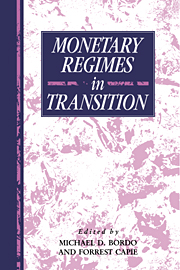Book contents
1 - Introduction
Published online by Cambridge University Press: 05 May 2010
Summary
We planned this volume of essays as an exercise in comparative economic history. Our objective was to examine different countries’ experiences with different monetary regimes. What, if anything, might be said about how different regimes fared when placed under stress? For example, when war broke out, or when there was some other change in the economic environment, how did that lead to a change, or perhaps a breakdown in a regime? If neither occurred, what was it that preserved the existing system? What was it, in short, that made some monetary regimes stable and durable, and others not?
Any comparison of the broad range of monetary regimes and experiences requires an analytic framework. In this Introduction we outline briefly some basic themes in the evolution of a monetary economy, discuss some of the basic kinds of stress that have commonly occurred, define “regime,” and consider the kinds of conditions that bring about transition to a new regime. We then turn to some associated themes for modern macroeconomics – the themes include credibility in policy stance, time inconsistency in policy, and the desirability of independence of monetary authorities. We conclude with a brief synopsis of the papers in the volume.
Some basic themes in the evolution of the monetary economy
Monetary economies have evolved slowly over a long period. The path is well known and is closely connected to the functions of money: as a medium of exchange, a unit of account, and a store of value (Morgan, 1965; Clower, 1967; Hicks, 1970). In the very earliest forms of exchange, transactions were carried out by barter.
- Type
- Chapter
- Information
- Monetary Regimes in Transition , pp. 1 - 12Publisher: Cambridge University PressPrint publication year: 1993



